
The Internal Macedonian Revolutionary Organization, was a secret revolutionary society founded in the Ottoman territories in Europe, that operated in the late 19th and early 20th centuries.

The Ilinden–Preobrazhenie Uprising, or simply the Ilinden Uprising of August–October 1903, was organized revolt against the Ottoman Empire, which was prepared and carried out by the Internal Macedonian-Adrianople Revolutionary Organization, with the support of the Supreme Macedonian-Adrianople Committee, which included mostly Bulgarian military personnel. The name of the uprising refers to Ilinden, a name for Elijah's day, and to Preobrazhenie which means Feast of the Transfiguration. Some historians describe the rebellion in the Serres revolutionary district as a separate uprising, calling it the Krastovden Uprising, because on September 14 the revolutionaries there also rebelled. The revolt lasted from the beginning of August to the end of October and covered a vast territory from the western Black Sea coast in the east to the shores of Lake Ohrid in the west.

The Kruševo Republic was a short-lived political entity proclaimed in 1903 by rebels from the Secret Macedonian-Adrianople Revolutionary Organization (IMRO) in Kruševo during the anti-Ottoman Ilinden–Preobrazhenie Uprising.

The Macedonian Struggle was a series of social, political, cultural and military conflicts that were mainly fought between Greek and Bulgarian subjects who lived in Ottoman Macedonia between 1893 and 1912. The conflict was part of a wider guerilla war in which revolutionary organizations of Greeks, Bulgarians and Serbs all fought over Macedonia. Gradually the Greek and Bulgarian bands gained the upper hand. Though the conflict largely ceased by the Young Turk Revolution, it continued as a low intensity insurgency until the Balkan Wars.
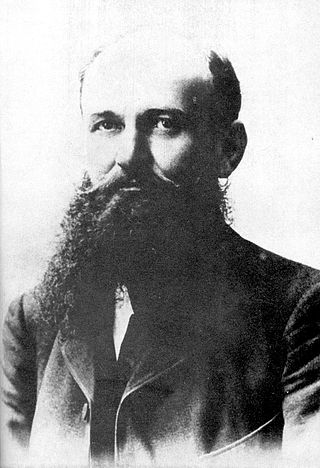
Gyorche Petrov Nikolov born Georgi Petrov Nikolov, was a Bulgarian teacher and revolutionary, one of the leaders of the Internal Macedonian Revolutionary Organization (IMRO). He was its representative in Sofia, the capital of Principality of Bulgaria. As such he was also a member of the Supreme Macedonian-Adrianople Committee (SMAC), participating in the work of its governing body. During the Balkan Wars, Petrov was a Bulgarian army volunteer, and during the First World War, he was involved in the activity of the Bulgarian occupation authorities in Serbia and Greece. Subsequently, he participated in Bulgarian politics, but was eventually killed by the rivaling IMRO right-wing faction. According to the Macedonian historiography, he was an ethnic Macedonian.
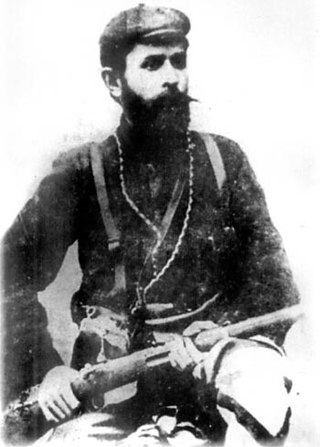
Nikola Yanakiev Karev was a Macedonian Bulgarian revolutionary. He was born in Kırşova and died in the village of Rayçani (Rajčani), both today in North Macedonia. Karev was a local leader of what later became known as the Internal Macedonian Revolutionary Organization (IMRO). He was also a teacher in the Bulgarian school system in his native area, and a member of the Bulgarian Workers' Social Democratic Party. Today he is considered a hero in Bulgaria and in North Macedonia.

Pitu Guli was an Aromanian revolutionary in Ottoman Macedonia, a local leader of what is commonly referred to as the Internal Macedonian Revolutionary Organization (IMRO).
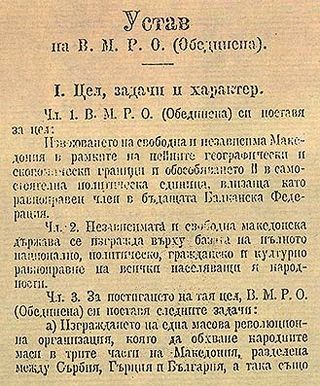
The Internal Macedonian Revolutionary Organization (United) (1925–1936) commonly known in English as IMRO (United), was the name of a revolutionary political organization active across the entire geographical region of Macedonia.

Yane Sandanski was a Macedonian Bulgarian revolutionary. He is recognized as a national hero in both Bulgaria and North Macedonia.
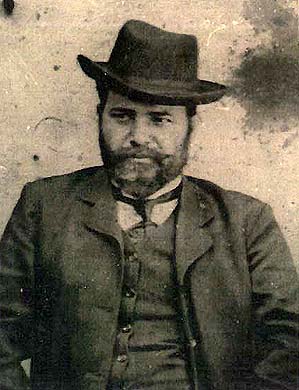
Petar Poparsov or Petar Pop Arsov was a Macedonian Bulgarian revolutionary, educator and one of the founders of the Internal Macedonian Adrianople Revolutionary Organization (IMARO). He is regarded as an ethnic Macedonian by the historiography in North Macedonia.

Boris Petrov Sarafov was a Bulgarian Army officer and revolutionary, one of the leaders of Supreme Macedonian-Adrianople Committee (SMAC) and Internal Macedonian Revolutionary Organization (IMRO). He is considered an ethnic Macedonian in North Macedonia, having identified occasionally as a Macedonian in his life.

The Independent State of Macedonia was a proposed puppet state of Nazi Germany during the Second World War in the territory of the Kingdom of Yugoslavia that had been occupied by the Kingdom of Bulgaria following the invasion of Yugoslavia in April 1941.
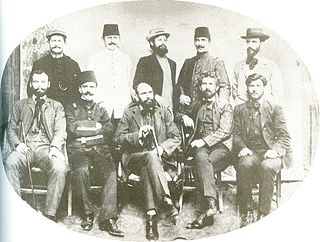
The People's Federative Party (Bulgarian Section) (Bulgarian: Народна федеративна партия (българска секция)) was a Bulgarian political party in the Ottoman Empire, created after the Young Turk Revolution, by members of the left wing of the Internal Macedonian Adrianople Revolutionary Organization (IMARO). The party functioned for one year from August 1909 until August 1910. The Party decided to name itself Bulgarian Section, since it was hoped that other nationalities from European Turkey would adopt its program and form their own ethnic sections, but this didn't happen. Its main political rival was the Union of the Bulgarian Constitutional Clubs.

Ivan Naumov, nicknamed Alyabaka or Alyabako was a Bulgarian revolutionary, a member of the Internal Macedonian-Adrianople Revolutionary Organization (IMARO).

Hristo Apostolov Matov was a prominent Macedonian Bulgarian revolutionary, philologist, folklorist and publicist and one of the leaders of the Bulgarian Macedonian-Adrianople Revolutionary Committees,.
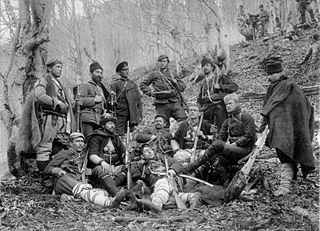
A cheta, in plural chetas, was an armed band organized by the mostly Bulgarian, Serbian, Albanian, Greek, Aromanian and Megleno-Romanian population on the territory of the Ottoman Empire that undertook anti-Ottoman activity. The cheta was usually led by a leader, called voivoda. The members of the chetas were called chetniks.

Petar (Pere) Naumov Toshev was a Bulgarian teacher and an activist of the Internal Macedonian-Adrianople Revolutionary Organization. In the historiography in North Macedonia he is considered an ethnic Macedonian revolutionary.

Autonomy for the region of Macedonia and Adrianople Thrace within the Ottoman Empire was a concept that arose in the late 19th century and was popular until ca. 1920. The plan was developed among Macedonian and Thracian Bulgarian emigres in Sofia and covered several meanings. Serbia and Greece were totally opposed to that set of ideas while Bulgaria was ambivalent to them. In fact Sofia advocated granting such autonomy as a prelude to the annexation of both areas, as for many Bulgarian emigres it was seen in the same way.

Macedonians as an obsolete terminology was used in regional and in ethnographic sense and had several meanings, different from these used mostly today. The name of Macedonia was revived on the Balkans during the early 19th century as result of the Western Europe-derived obsession with Ancient Greece. The designation Macedonian arose at the eve of the 20th century and was used beyond but its meanings have changed during the time, and some of them are rarely used anymore.

Due to the lack of original protocol documentation, and the fact its early organic statutes were not dated, the first statute of the clandestine Internal Macedonian Revolutionary Organization (IMRO) is uncertain and is a subject to dispute among researchers. The dispute also includes its first name and ethnic character, as well as the authenticity, dating, validity, and authorship of its supposed first statute. Certain contradictions and inconsistencies exist in the testimonies of the founding and other early members of the Organization, which further complicates the solution of the problem. It is not yet clear whether the earliest statutory documents of the Organization have been discovered. Its earliest basic documents discovered for now, became known to the historical community during 1960s.


















